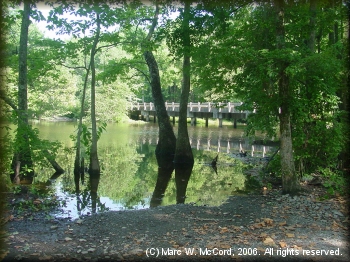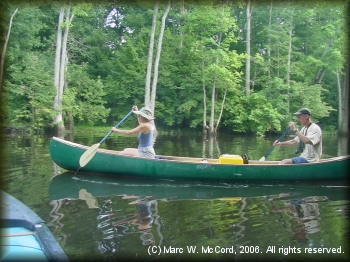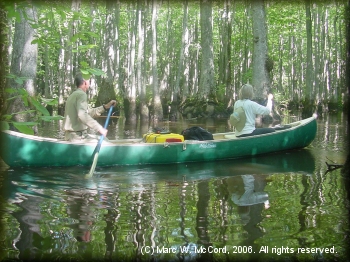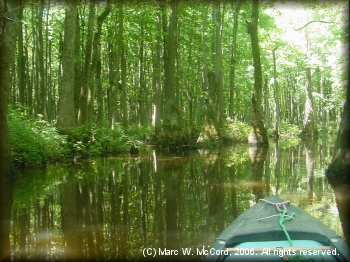Sitting in quiet reflection beside the placid Cache River in the Black Swamp of northeastern Arkansas, I think back on three entertaining and very interesting days of canoeing the Cache River and Bayou deView. Our quest was to see and photograph the elusive and mystical Ivory-billed Woodpecker, which was believed to be extinct for over 60 years.
Arriving in Brinkley, Arkansas the previous day, I met Larry Rice and Mara Kahn on Sunday, August 6, 2006, for a trip into the fabled Black Swamp. Brinkley is a small town that was almost unknown until Gene Sparling sighted the bird of our quest while kayaking this area in 2004. It is bounded by the Cache River National Wildlife Refuge, Rex Hancock Black Swamp, and the Dagmar Wildlife Management Area. After exchanging introductions and greetings we headed for the Black Swamp campsite between the small towns of Augusta and Cotton Plant, which I had staked out the previous day, and which was to serve as our base camp for the next four days.
August in the Black Swamp is not for everybody. Days were very hot and humid. Nights became tolerably cooler around 5 to 6 AM, just in time to begin reheating when the sun rose in the sky above. Mosquitos, flies, grasshoppers, bees and similar pests were plentiful. One truly needs to love the outdoors to abandon air-conditioned comfort and the conveniences of civilized, big city life to journey into a place as remote and natural as this.
After Larry and Mara had set up their camp we reviewed our options for places to paddle and our shcedule of when to go to each, some of which I had previously visited and others which had only recently been re-opened to the public after having been closed for nearly two years while scientists, ornithologists and other researchers scoured the Big Woods area for proof that the Ivory-billed Woodpecker lives today.
 Opting for a short first day of searching, we loaded Larry and Mara's canoe on my van and headed for SH 38 just east of Cotton Plant, then launched our canoes for a short journey above and below SH 38. Last year, Jill Britt and I had paddled above SH 38, but the US Fish and Wildlife Service had the area below SH 38 closed and game wardens were posted at all access points to enforce that rule, so going below SH 38 was a first for all of us.
Opting for a short first day of searching, we loaded Larry and Mara's canoe on my van and headed for SH 38 just east of Cotton Plant, then launched our canoes for a short journey above and below SH 38. Last year, Jill Britt and I had paddled above SH 38, but the US Fish and Wildlife Service had the area below SH 38 closed and game wardens were posted at all access points to enforce that rule, so going below SH 38 was a first for all of us.
Larry and Mara had just arrived from their home in Buena Vista, Colorado, where temperatures were in the 60's and 70's. Living in Dallas, Arkansas was actually a few degrees cooler than home, though it was difficult to tell, and the humidity in the swamp was much higher! My companions on this trip quickly discovered what was awaiting them for the next three days. Unlike the desert of Arizona, this was NOT a "dry heat"!
The short trip on Bayou deView introduced Larry and Mara to what they could expect to see for the rest of our excursion. For all the heat and humidity, this is a great time to visit the swamp, and we were sticken with awe and wonderment at the incredible, natural beauty of this remote part of Arkansas. Trees and plants were in full bloom, and the vast array of shades of green were everywhere. It was hard to imagine just how drought-stricken this area really is, especially when we discovered that the bayou and river actually had more than adequate water for our trips. Having been here before, I was immediately surprised by what I did NOT see - snakes!
On previous visits I saw snakes everywhere, from the passive but venomous cottonmouth water mocassin to the banded, broadbanded, yellow-belly and common brown non-venomous watersnakes - they were everywhere. I estimated my paddling speed in 2005, at 3 spm (snakes per minute). This time, we saw NONE, though I am quite sure they were there - somewhere. After all, this IS a swamp in the Big Woods, which is also home to rattlesnakes and copperheads, yet, after four days not one snake was seen by any of us.
Gene Sparling, who first rediscoverd the Ivory-billed Woodpecker in 2004, was invited to join us, but declined, saying that we needed to go in winter when the vegetation is bare and opportunities for sighting the great bird are much better. It is difficult to argue with his logic, and he didn't even mention the heat and humidity or mosquitos, but the sawmp is gorgeous when in bloom, and Larry had a deadline for a story he is writing to be published in "Canoe and Kayak" Magazine either late in 2006, or early in 2007. All those greens, yellows, whites and blues just gave a pallet of colors that are not to be found in winter.
Expecting low water and a lot of dragging over deadfallen trees, we were pleasantly surprised to find more than adequate water in both the Cache River and Bayou deView. It was a lot higher than when Jill and I paddled these streams last year. We were thrilled to find almost no trash and debris on these two streams, owing partly to their remoteness, as well as the fact that few people venture here. Those that do are more likely to be collecting trash for proper disposal rather than littering a beautiful and pristine place like the Black Swamp and the Big Woods. I would bet that fewer than 5% of the local population has any idea of the treasures that sit in their backyard.
 Though generally clean, the Cache River is not clear. Rather, it is a brown, muddy-looking stream with a very modest gradient and an almost imperceptible flow. By contrast, the much narrower Bayou deView ranges from a black-green color in open areas to a tannic acid, tea-colored hue amid the giant, bald cypress trees in the Black Swamp. The bottom of the bayou was frequently visible in the cool and refreshing waters, and we frolicked there without getting so much as a single leech or other parasitic attack.
Though generally clean, the Cache River is not clear. Rather, it is a brown, muddy-looking stream with a very modest gradient and an almost imperceptible flow. By contrast, the much narrower Bayou deView ranges from a black-green color in open areas to a tannic acid, tea-colored hue amid the giant, bald cypress trees in the Black Swamp. The bottom of the bayou was frequently visible in the cool and refreshing waters, and we frolicked there without getting so much as a single leech or other parasitic attack.
On Monday, August 7, we launched on the Cache River from the SH 260 public access off SH 33 in Woodruff County, a few miles south of Augusta, and paddled nearly 14 miles back to our base camp, the last half mile or so entailing working our way through a cypress swamp with no clearly defined channel, and only a GPS waypoint to guide us. We eventually found some markers on trees that indicated the proper route, but our GPS took us directly to the boat ramp and our campsite just a few yards from it. I would not go into that swamp without my GPS and extra batteries! Next to my canoe, paddle and PFD, it is the most valuable piece of gear I have with me.
Along the way, we paddled at an easy 3.1 mph pace on a gentle current, managing to stay in the shade of banks lined with sycamore, oak, elm and cypress trees that gave us a little respite from the broiling sun. The densely forested woods were beautiful in all their verdant bloom, and the canopy made a perfect barrier to block our view of any Ivory-billed Woodpeckers or other birds that were present.
We shot a lot of photos, talked about river trips we had taken, came up with workable solutions to most of the world's most pressing problems, discussed plans for future trips we are planning together and separately, and myriad other things, but the object of our quest was neither heard nor seen. Still, it was fantastic just to be in the Big Woods paddling with friends and enjoying some of Mother Nature's wonderment.
 Tuesday, August 8, was our third day of paddling, and we returned to Bayou deiew where we launched from the SH 17 access just northwest of Brinkley. We began with a short, upstream paddle until deadfall and low water gave us reason enough to turn around, then we headed downstream for a couple of eventful hours during which time we definitely heard what sounded like the signature double tap drumming of the Ivory-billed Woodpecker and made two sightings that were, quite possible, the bird of our quest.
Tuesday, August 8, was our third day of paddling, and we returned to Bayou deiew where we launched from the SH 17 access just northwest of Brinkley. We began with a short, upstream paddle until deadfall and low water gave us reason enough to turn around, then we headed downstream for a couple of eventful hours during which time we definitely heard what sounded like the signature double tap drumming of the Ivory-billed Woodpecker and made two sightings that were, quite possible, the bird of our quest.
The first sighting was made shortly after we heard drumming coming from both sides and slightly behind us. Simultaneously, Larry and I observed a very large, black bird cross the bayou in front of us at a distance of perhaps 20-30 yards and at an altitude of about 30 feet. We only got about 3 seconds of viewing before the bird landed on the trunk of a tree in a swampy forest full of trees, where he disappeared. We observed no clear markings that would positively identify the bird we saw as being an Ivory-billed Woodpecker, but it was quite large, very black and flew with the grace and smoothness that is characteristic of the great bird we were seeking. This bird did not fly in the classic undulating pattern of most birds, but rather flew much more like a predator such as an eagle, hawk, falcon or other graceful bird. And, rather than landing on a branch, it landed on the trunk of a tree the way woodpeckers frequently do.
The drumming we heard prior to this sighting gave me the lasting impresson of two birds communicating with one another. The sounds clearly came from either side of the swamp, and sounded like they were originating within one tenth mile of our position. The drumming also had a distinct sound like it was coming from a dead-standing tree, producing a hollow, loud sound that could be heard for quite some distance.
The second possible sighting was mine alone. From the lead boat position, about 20-25 yeards in front of Larry and Mara, I observed a very large, black bird with clearly prominent white, trailing edge wing feathers bolt from one tree and fly off into the forest on my left side. The sighting, like the first one, was a scant 3-5 seconds. The bird started his flight about 15 yards in from of me at an altitude of perhaps 25-30 feet. I never saw its head or back, observing the bird only from under and behind, but those white trailing edge wing feathers were quite distinct. The sighting followed a period of a few minutes when we clearly heard the double tap drumming on a hollow, dead tree on our left side.
This sighting came within 20 minutes of the first one, and also did not allow adequate time or perspective for a positive identification, though it flew with the same characteristics and was preceeded by the same drumming as we heard prior to the first sighting. It is entirely possible that the bird I saw in the second sighting was the same one that Larry and I both saw in the first sighting.
 We rode a gentle, but steady current until we left the forest cover for a clear-cut power line channel where we turned around and headed back to our vehicles. We had a little more effort getting back upstream in some places due to the good downstream current, but we never had to get out of our boats. Well, okay, I had to get out of mine once, but it was not intentional. I passed over a submerged tree truck that was not visible, then flipped my boat. Fortunately, the water was less than waist deep, and I was able to bail the canoe and get back in for the rest of the trip back to our vehicles, where we changed clothes, then headed to a restaurant in Brinkley, collected our thoughts, compared notes, put down on paper all we had done and seen for three days and ate lunch.
We rode a gentle, but steady current until we left the forest cover for a clear-cut power line channel where we turned around and headed back to our vehicles. We had a little more effort getting back upstream in some places due to the good downstream current, but we never had to get out of our boats. Well, okay, I had to get out of mine once, but it was not intentional. I passed over a submerged tree truck that was not visible, then flipped my boat. Fortunately, the water was less than waist deep, and I was able to bail the canoe and get back in for the rest of the trip back to our vehicles, where we changed clothes, then headed to a restaurant in Brinkley, collected our thoughts, compared notes, put down on paper all we had done and seen for three days and ate lunch.
At the end of the meal We bade farewell. Larry and Mara headed for the Eleven Point River in Missouri for another two days of paddling between Greer Springs and Riverton. I camped another night in the Black Swamp, then made a 2-day trip back to Dallas, stopping along the way and visiting some outfitters on the Caddo and Ouachita Rivers, camping Wednesday night on the Lower Mountain Fork River just outside Broken Bow, Oklahoma, and arriving safely back home late Thursday afternoon.
It was a really special trip that will never be forgotten. Larry and Mara invited me to come to Buena Vista and stay with them anytime I want to run the Arkansas, Piedra, Dolores, Animas and other nearby rivers in Colorado, where it is MUCH cooler than anything around here! I definitely intend to take them up on their offer.


